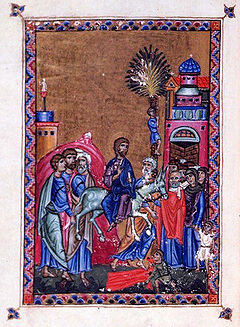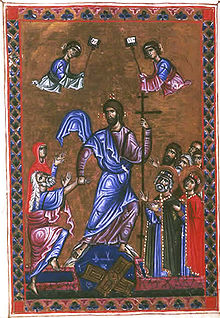- Melisende Psalter
-

The Melisende Psalter (London, British Library, Egerton MS 1139) is an illuminated manuscript commissioned around 1135 in the crusader Kingdom of Jerusalem, probably by King Fulk for his wife Queen Melisende. It is a notable example Crusader art, which resulted from a merging of the artistic styles of Roman Catholic Europe and the Eastern Orthodox Byzantine Empire.
Seven scribes and illuminators, working in the scriptorium built by the crusaders in the Church of the Holy Sepulchre in Jerusalem, were involved in the creation of the psalter. It measures 21.6 centimetres by 14 centimetres.
This manuscript forms part of the Egerton Collection in the British Library.
Contents
The New Testament cycle
The first twenty-four illustrations (on each side of the first twelve folios) depict scenes from the New Testament. New Testament images were commonly found at the beginning of western psalters, unlike in eastern psalters, but in this case the images depict scenes more common in the Eastern Orthodox liturgy. The scenes depicted are the Annunciation, Visitation, the Nativity, the Adoration of the Magi, the Presentation of Jesus at the Temple, the Baptism of Jesus, the Temptation of Christ, the Transfiguration, the Raising of Lazarus, the Triumphal entry into Jerusalem (see illustration), the Last Supper, the Washing of the Feet, the Agony in the Garden, the Betrayal of Judas, the Crucifixion of Jesus, the Descent from the Cross, the Lamentation, the Harrowing of Hell, the Three Marys at the Tomb, and the Deesis.
These illustrations were made by an illuminator named Basilius, who signed the last illustration (pictured above) Basilius me fecit, and is the only named illuminator or scribe of this manuscript. Nothing is known about Basilius, but because of his Greek name it has been suggested that he was a Byzantine artist; it is also possible that he was a western artist who had been trained in a Greek style, maybe in Constantinople; or he may have been an Armenian Catholic, familiar with both Catholic and Orthodox traditions.
The calendar
Folios 13-21 contain the calendar, which is strikingly similar to psalter calendars produced in England in the same period. It appears to be based on a calendar of St. Swithun's church in Winchester. The calendar is filled with English saint days rather than those more popular in Jerusalem, and one name, St. Martin of Tours, a saint popular throughout Europe, is written in gold, for unknown reasons. Three crusader-specific dates are mentioned in the calendar: the capture of Jerusalem on July 15, the death of Baldwin II on August 21, and the death of his wife Morphia on October 1. Each month also has a medallion with a sign of the Zodiac, illustrated in a Romanesque style with heavy Islamic influences.
The psalter
Folios 22-196 contain the Latin psalms written in a northern French script. A third illuminator painted the initial letters of each psalm. Some initials take up the entire side of a leaf, and are drawn with gold lettering on a purple background. They show influence from Italian and Islamic art, possibly suggesting that the artist was trained in Muslim-influenced southern Italy.
Prayers to the saints
The scribe who wrote the psalms also wrote a series of prayers on folios 197-211, dedicated to nine saints - the Virgin Mary, St. Michael, St. John the Baptist, St. Peter, St. John the Evangelist, St. Stephen, St. Nicholas, St. Mary Magdalene, and St. Agnes. The prayers are accompanied by paintings of the saints by a fourth illuminator trained in a Romanesque style, but his technique also shows an attempt to incorporate a Byzantine style. There are a few blank and undecorated spaces in this section of the psalter, and it may be incomplete.
The covers
The ivory covers, decorated with some small turquoise beads, show scenes from the life of King David and from the Psychomachia of Prudentius on the front side, and another king performing the Six Works of Mercy from the Gospel of Matthew on the back side, both showing influence from Byzantine, Islamic, and western art. The geometric designs on the covers are especially influenced by Islamic art. The king on the back side is dressed in Byzantine imperial clothes, but most likely represents a crusader king, perhaps Fulk. There is a carving of a falcon above him, which is possibly a clue that the king is Fulk, as "falcon" and "Fulk" in Old French were both "Fouque." Underneath the falcon the name "Herodius" is carved, Latin for Gyrfalcon; although the artist has not signed in the same way Basilius has.
The spine of the psalter is decorated with Byzantine silk and silver thread, as well as red, blue, and green Greek crosses (which are also found in the royal arms of the kingdom). The spine was stitched by an artisan who was perhaps a westerner trained in a Byzantine style, as his stitching is not as smooth as other examples of Byzantine silk spines made by native Greeks.
Date and recipient
The exact date of the psalter, and for whom it was made, is unknown, although it is obviously made for a noble woman of the kingdom, based on the use of Byzantine styles (considered to be "aristocratic" by the crusaders), the depictions of kings, and the use of feminine word endings in the Latin prayers. Through circumstantial evidence Melisende can probably be identified as the recipient. The English influence in the calendar and elsewhere likely comes from Fulk, whose Angevin relatives ruled England at the time. It is also notable that aside from the capture of Jerusalem, the only crusader-specific dates in the calendar are the deaths of Melisende's parents. The mixture of Catholic and Orthodox elements in the psalter may reflect Melisende's mixed upbringing (Baldwin was Catholic and Morphia was an Armenian of the Greek Orthodox faith).
If Melisende was indeed the recipient, then the psalter was most likely commissioned by Fulk, probably around 1135. Prior to this, Fulk and Melisende had been fighting for superiority in the kingdom, and Melisende had allied with rebels against Fulk; by 1134 they had reconciled, and the psalter had to have been written after 1131, the date of Baldwin II's death. On the other hand, it could have been written anytime before Melisende's death in 1151. Palaeographical comparisons to other texts produced in Jerusalem suggest it was written in the 1140s (or even the 1150s), but the later texts may have used the Melisende Psalter as a source.
The manuscript was perhaps owned by Grande Chartreuse, Grenoble, in the early 19th century. By about 1840 it was owned by A. Comarmond, director of the Palais-des-Arts, Lyons. Its next owner was Guiglielmo Libri (b. 1802, d. 1869), who is most famous for stealing medieval mansucripts from French public libraries; he sold it to the London book dealers Payne and Foss, who in turn sold to the British Museum in November 1845.
Sources
- Hugo Buchthal, Miniature Painting in the Latin Kingdom of Jerusalem. Clarendon Press, 1957.
- Jaroslav Folda, The Art of the Crusaders in the Holy Land, 1098-1187. Cambridge University Press, 1995.
- Bianca Kühnel, Crusader Art of the Twelfth Century - A Geographical, an Historical, or an Art Historical Notion? Berlin, 1994.
- Jonathan Riley-Smith, The Oxford History of the Crusades. Oxford University Press, 2002.
- Barbara Zeitler, "The Distorting Mirror: Reflections on the Queen Melisende Psalter," in Through the Looking Glass: Byzantium Through British Eyes. Papers From the Twenty-Ninth Spring Syposium of Byzantine Studies, London, March 1995, eds. Robin Cormack and Elizabeth Jeffreys. Variorum, 2000.
See also
External links
Categories:- 1130s books
- Kingdom of Jerusalem
- Illuminated psalters
- Egerton collection
Wikimedia Foundation. 2010.


